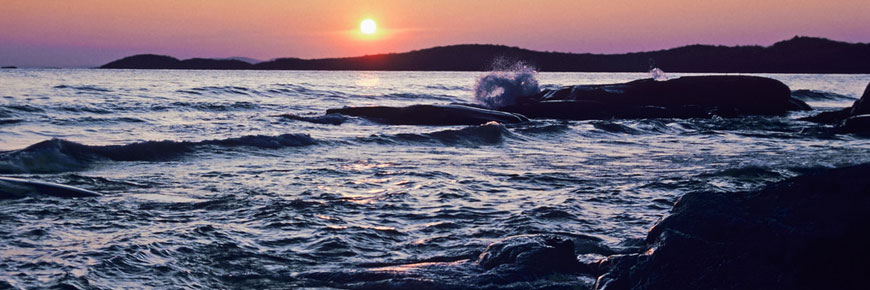
Management Plan Progress Report 2019-2020
Pukaskwa National Park
Download the PDF Version Here (English 6.8 MB)
Management plans identify the long-term strategic direction and vision for Parks Canada places. Plans provide a framework for site management, aligning with the Agency’s mandate, vision and strategic outcomes. Management plans are guiding documents for decision making and planning. This annual update serves as a progress report to partners, stakeholders, and the public outlining our work in implementing the key strategies from the management plan over the last year.
Key Strategy 1: AN ENDURING RELATIONSHIPHonouring the Anishinaabek and Métis, and their connection to the land known as Pukaskwa
• Continued fostering a close relationship with Biigtigong Nishnaabeg throughout the year by participating in quarterly meetings with an Operational Working Group
• Made efforts to increase First Nation employee recruitment by hosting employment coaching sessions in local communities and by providing 4 Biigtigong Nishnaabeg students an 8 week work placement experience
• Local Indigenous community members continued to use the park for traditional activities like camping, fishing, medicinal harvest and trapping throughout all seasons
• Indigenous youth reconnected with the land during a summer youth camp, where they learned from elders, visited and held ceremony at a culturally significant site and later provided an Anishinaabemowin name for the site: Aankoobjignikaang (pronounced An-koob-ej-ne-kong), translated to English as “place of (the) ancestors”
• Supported cultural programs for youth at Biigtigong Nishnaabeg’s annual moose camp. Park staff also attended spring and fall community camps, gaining a deeper understanding of local Indigenous tradition and culture
• Hosted a cultural resource management workshop with Biigtigong Nishnaabeg, which led to drafting of a joint protocol for archaeological objects, and the display of the cultural artifact collection at the Biigtigong Nishnaabeg Pow-wow
Key Strategy 2: A WILDERNESS SUSTAINED: Experiencing Pukaskwa’s wilderness through strengthened ecosystems
• Enhanced knowledge on the condition of ecological integrity through the collection of data and assessment for 12 of the 15 monitoring measures
• Made improvements to the long-term Ecological Integrity Monitoring Program to ensure a sustainable program that incorporates traditional and scientific knowledge
• Ensured that key ecosystem processes and species were maintained through the completion of 9 impact assessments on projects and work
• Continued to make progress on species at risk recovery actions including setting up 6 remote recorders to monitor bats; inventorying snapping turtles using e-DNA from water samples; and developing a mobile exhibit to educate visitors and Canadians about how they can help recover at-risk species
Key Strategy 3: A “SUPERIOR” CONNECTION: Making Pukaskwa more relevant to Canadians
• Visitation increased by 25% in 2019 compared to 2010 (the baseline year), exceeding the 10% goal set in the management plan, allowing a greater number of Canadians to discover the park
• Achieved 54% occupancy in oTENTik tents in Hattie Cove in the first full year of operations (May to October), with 86% occupancy in peak season (July and August), demonstrating this new camping opportunity engages, interests and motivates Canadians to visit
• Hosted ~40 students from Ocean Bridge, a project providing an opportunity for students from across Canada to volunteer and assist in initiatives that contribute to education and awareness of protecting our oceans and large bodies of water, like the Great Lakes. Volunteers cleared driftwood from a walking path on Horseshoe Beach and Middle Beach to enable visitors to have a safe visit with low ecological impacts.
AREA Management Strategy: HATTIE COVE
• Completed ~2 kilometers of road resurfacing, with new underground infrastructure and parking lot lighting, to ensure that critical assets required for a safe, reliable visit are in place and that visitors feel comfortable and continue to return to Pukaskwa for years to come
• Refinished the exterior of the park administration complex, improving the heating efficiency and reducing carbon emissions, contributing to the government of Canada’s carbon reduction goals
• Replaced the exterior roof and interior supporting structures on the Visitor Centre in Hattie Cove, extending the longevity of the building so that it can continue to be a cozy welcoming space for visitors well into the future
• Visitors continued to learn about local Indigenous culture at the refreshed Anishinaabe Camp, at a fire circle where drum socials were regularly held, and at new interpretive programs featuring clay (‘Magical Mud’) and historic wayfinding using melody (‘Singing Landscapes’)
• Lakehead University students participated in invasive species monitoring along the road to Hattie Cove and detected several nonnative invasives that will be eradicated and removed in the summer of 2020
AREA Management Strategy: LAKE SUPERIOR COAST
• A collaborative research partnership with Environment and Climate Change Canada, Carleton University, and the U.S. Geological Survey, Great Lakes Science Centre assessed population trends and the occurrence of flame retardants in colonial waterbirds
• Backcountry camping continued to increase in 2019, being 22% higher than 2016 levels -- a notable increase, in part due to the opening of Mdaabii Miikna, the new 24 km loop trail
• Replaced or reinforced over 200 trail bridge structures on backcountry and frontcountry trails to provide a safe, enjoyable experience for visitors using trails adjacent to Lake Superior in Pukaskwa National Park
• Initiated discussions with Biigtigong Nishnaabeg about engaging local community members and youth in a partnership project that will contribute to the protection of aquatic species along Lake Superior’s coast
- Date modified :